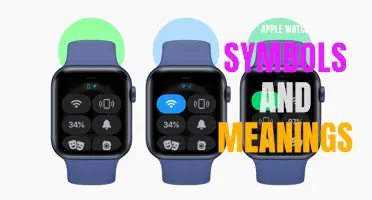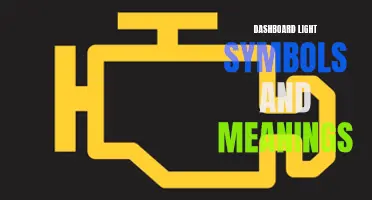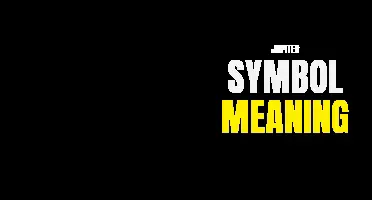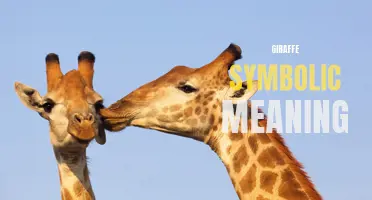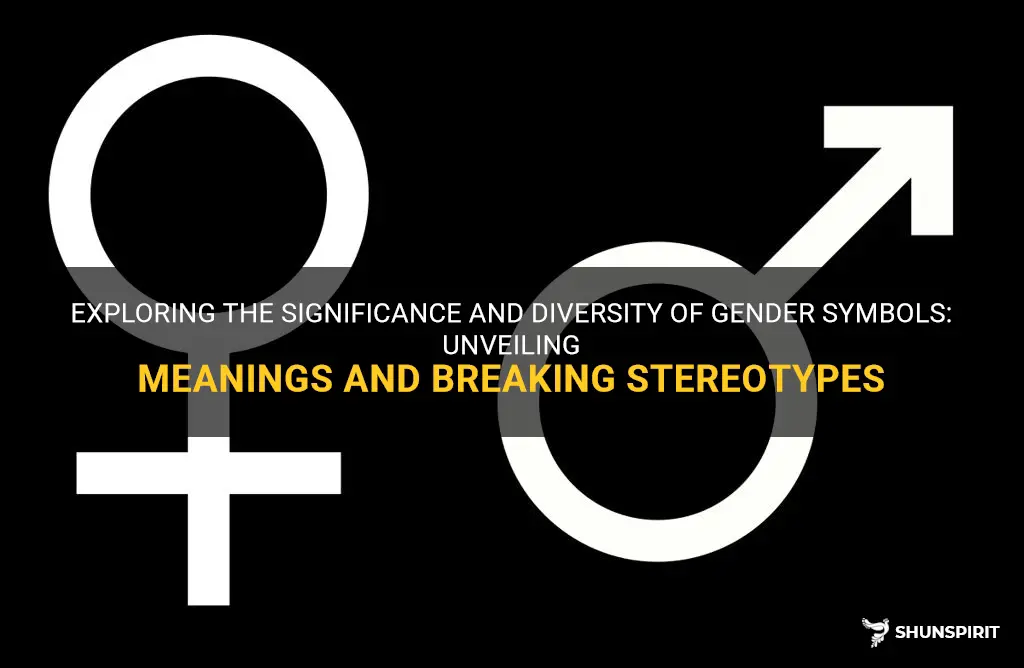
Gender symbols are a powerful way to visually represent the diversity and complexity of gender identities. These symbols not only encompass traditional gender identities, but also acknowledge and celebrate the existence of non-binary and genderqueer individuals. By providing a recognizable and inclusive symbol, these representations challenge societal norms and promote understanding and acceptance of all genders. In this article, we will explore the history and meanings behind gender symbols, shedding light on the beauty and significance of these graphic representations.
What You'll Learn
- What do the gender symbols of male and female represent?
- How have the meanings of gender symbols evolved throughout history?
- Are gender symbols universal across different cultures or do they vary?
- Can the meanings of gender symbols change over time?
- What impact do gender symbols have on society and individuals' understanding of gender?

What do the gender symbols of male and female represent?
The gender symbols of male and female are universally recognized symbols that represent the sexes. These symbols are commonly used to indicate the gender of individuals, as well as to represent concepts related to gender and sexuality.
The gender symbol for male is a circle with an arrow pointing forward and to the right. This symbol is derived from the symbol for the planet Mars, which represents the Roman god of war. It is believed that the arrow in the male symbol represents a spear or sword, symbolizing strength and virility.
On the other hand, the gender symbol for female is a circle with a small cross at the bottom. This symbol is derived from the symbol for the planet Venus, which represents the Roman goddess of love and beauty. The cross in the female symbol is said to represent a mirror, symbolizing femininity and fertility.
These symbols have been used for centuries to represent the binary concept of gender, with the male symbol representing masculinity and the female symbol representing femininity. However, it is important to note that these symbols do not encompass the full spectrum of gender identities and expressions that exist today. They are based on traditional understandings of gender and may not accurately reflect the experiences of individuals who identify outside of the traditional male and female binary.
In recent years, there has been a push for more inclusive gender symbols that represent a broader range of gender identities. Some proposed symbols include a combination of the male and female symbols to represent non-binary or genderqueer individuals, as well as symbols specific to transgender and gender non-conforming individuals. These symbols aim to highlight the diversity of gender identities and challenge the notion of a strict binary understanding of gender.
While the traditional male and female symbols continue to be widely recognized and used, it is important to acknowledge and respect the experiences and identities of individuals who do not fit into these binary categories. By recognizing and using more inclusive gender symbols, we can create a more inclusive and affirming society for all individuals, regardless of their gender identity.
Understanding the Kokopelli Symbols and Meanings: A Guide to the Ancient Native American Icon
You may want to see also

How have the meanings of gender symbols evolved throughout history?
In today's society, gender symbols are commonly used to represent the binary concepts of male and female. These symbols, depicted as ♂ for male and ♀ for female, have become deeply ingrained in our culture and are used to denote biological sex. However, the meanings of gender symbols have evolved throughout history, reflecting changing attitudes towards gender and sexuality.
The use of gender symbols can be traced back to ancient civilizations such as the Romans and Greeks, who associated certain symbols with specific deities. For instance, the symbol for male in ancient Rome was a triangle pointing upwards, representing the phallus, while the symbol for female was a cross within a circle, representing the mirror. These symbols were used in religious and cultural contexts to reflect the perceived qualities and roles associated with each gender.
During the Middle Ages, the meanings of gender symbols became closely tied to Christian theology. The symbol for male, a shield and spear, represented the warrior and protector, while the symbol for female, a mirror, represented beauty and femininity. These symbols reinforced traditional gender norms and emphasized the idea of women as objects of male desire and male dominance.
In the 20th century, with the advent of the feminist and LGBTQ+ movements, the meanings of gender symbols began to shift. As people started questioning traditional gender roles and identities, the binary nature of the male and female symbols came under scrutiny. Many individuals and groups advocated for new symbols that could represent non-binary, transgender, and genderqueer individuals.
One popular non-binary symbol that emerged during this time was the symbol for "third gender", ⚧. This symbol is a combination of the male and female symbols, with a cross added to the bottom of the female symbol. It represents those who do not identify strictly as male or female and promotes inclusivity and acceptance of gender diversity.
In recent years, there has been a growing recognition of the limitations of the traditional gender symbols. Many people argue that these symbols reinforce the outdated gender binary and fail to represent the diverse experiences and identities of individuals. As a result, new symbols and representations are being developed to challenge and expand our understanding of gender.
For example, some individuals use the symbol of a circle with an arrow pointing upwards to represent non-binary or genderqueer identities. This symbol is designed to be more inclusive and flexible, allowing individuals to express their gender identity outside of the male/female binary.
In conclusion, the meanings of gender symbols have evolved significantly throughout history. From ancient civilizations to modern-day activism, these symbols have reflected changing attitudes towards gender and sexuality. As society continues to challenge and expand traditional notions of gender, we can expect the meanings of gender symbols to continue evolving and diversifying.
Decoding the Mystery: What Does the Bell Symbol Mean on a Text Message?
You may want to see also

Are gender symbols universal across different cultures or do they vary?
Gender symbols, such as the ones used to represent male and female, are commonly seen in many societies and are found on bathroom doors, clothing labels, and other places where gender needs to be indicated. However, are these symbols universal across different cultures, or do they vary?
The use of gender symbols can be traced back to ancient times, with ancient Egyptian hieroglyphics featuring symbols for male and female. These symbols were often associated with gods and goddesses, which were an important part of Egyptian mythology. Similarly, ancient Greek and Roman civilizations also used gender symbols to represent male and female deities.
In modern times, the use of gender symbols has become more widespread and standardized. The most commonly used symbols are the ♂ symbol for male and the ♀ symbol for female. These symbols are widely recognized in many Western countries and are often used to indicate the gender of a person or object.
However, it is important to note that gender symbols can vary across different cultures. In some cultures, different symbols may be used to represent male and female. For example, in Japan, the 王 symbol is commonly used to represent males, while the 女 symbol is used to represent females. These symbols might not be instantly recognizable to individuals from other cultures.
In addition to variations in the actual symbols used, there may also be differences in how gender symbols are interpreted and understood across cultures. In some cultures, gender is seen as a binary concept, with individuals being either male or female. In other cultures, gender is seen as more fluid, with individuals identifying as a mix of male and female or as a different gender altogether. This can influence how gender symbols are viewed and understood within a particular cultural context.
Furthermore, the meaning and significance of gender symbols can also change over time. As societies become more aware of gender diversity and inclusivity, there is a growing recognition that not all individuals identify as strictly male or female. This has led to discussions and debates about the use of gender symbols and whether they are inclusive of all gender identities. Some argue that gender symbols should be updated or replaced with more inclusive symbols that reflect the full spectrum of gender identities.
In conclusion, while gender symbols such as the ones used to represent male and female are widespread and recognized in many cultures, there can be variations in the symbols used across different cultures. Additionally, the interpretation and understanding of gender symbols can vary depending on the cultural context and societal understanding of gender. As societies become more aware of gender diversity, there may be changes in how gender symbols are interpreted and used in the future.
Understanding the Meaning of the Lock Symbol on Text Messages
You may want to see also

Can the meanings of gender symbols change over time?
Gender symbols are an important aspect of society that represent and denote identities and roles related to gender. However, like other symbols, the meanings of gender symbols can change over time due to various factors such as cultural shifts, social progress, and changes in understanding and perceptions of gender.
Historically, gender symbols have often been depicted using traditional binary representations, with the male symbol ♂ representing masculinity and the female symbol ♀ representing femininity. These symbols originated in ancient Greece, where they represented the gods Mars (male) and Venus (female) respectively. Over time, these symbols became widely recognized and used to differentiate between male and female characteristics and roles.
However, as societies have become more inclusive and understanding of gender diversity, the meanings associated with gender symbols have started to evolve. With the rise of feminism and the LGBTQ+ rights movement, there has been a greater recognition of non-binary and transgender individuals and their unique gender identities. This has led to the need for symbols that represent identities beyond the traditional male and female binary.
As a result, new gender symbols have emerged to encompass a broader range of gender identities. One such symbol is the transgender symbol, which combines elements of the traditional male and female symbols to represent individuals who identify as neither exclusively male nor female. This symbol consists of a circle with an arrow pointing diagonally upwards and to the right, intersected by a horizontal line. It exemplifies the changing understanding and inclusion of gender diversity in contemporary society.
The meanings of gender symbols can also change in relation to specific cultures and communities. For example, in some Indigenous cultures, there are longstanding traditions that recognize gender diversity beyond the male and female binary. These cultures may have their own unique symbols and understandings of gender that differ from mainstream society. These symbols often reflect the specific cultural context and understanding of gender within that particular community.
Furthermore, the meanings of gender symbols can be influenced by political and social movements. For instance, the non-binary or genderqueer symbol, which consists of a merged male and female symbol with a cross through it, represents individuals who identify as neither exclusively male nor female. This symbol has gained prominence in recent years as part of the broader movement for gender equality and recognition of non-binary identities.
In conclusion, the meanings of gender symbols can indeed change over time. The recognition and inclusion of non-binary and transgender individuals, as well as the influence of cultural, political, and social factors, all contribute to the evolving meanings of gender symbols. As society continues to progress and understand the complexities and fluidity of gender, it is likely that new symbols will continue to emerge, reflecting a more diverse and inclusive understanding of gender identities.
Understanding Hyundai Santa Fe Dashboard Symbols and Their Meanings
You may want to see also

What impact do gender symbols have on society and individuals' understanding of gender?
Gender symbols are ubiquitous in society, adorning restroom doors, social media profiles, and even clothing. These symbols, typically represented by a male and female figure, are meant to indicate the assigned gender associated with a particular space or individual. However, their impact extends beyond simple signage - they shape our understanding of gender and influence societal norms and expectations.
One major effect of gender symbols is the reinforcement of gender binaries. By depicting only two options - male and female - these symbols limit the recognition and acceptance of non-binary and gender diverse identities. Individuals who do not conform to these rigid categories may feel unseen, invalidated, and excluded. This perpetuates the notion that gender is an either-or concept, neglecting the full spectrum of gender identities that exist.
Moreover, gender symbols can reinforce societal stereotypes and expectations. The male symbol is often associated with strength, dominance, and assertiveness, while the female symbol is linked to nurturing, passivity, and beauty. These stereotypes can lead to harmful gender norms, such as the expectation that men should not show vulnerability or that women should prioritize their appearance over other qualities. By perpetuating these stereotypes, gender symbols contribute to gender inequality and restrict an individual's freedom to express themselves authentically.
In addition, gender symbols can also perpetuate cisnormativity - the assumption that everyone identifies with the gender assigned at birth. This assumption ignores the experiences of transgender and non-binary individuals, who may not feel represented or included by these symbols. Consequently, this lack of representation can contribute to feelings of marginalization and reinforce societal stigma towards those who do not conform to traditional gender norms.
However, it is important to note that not all perspectives on gender symbols are negative. For some individuals, gender symbols can provide a sense of safety and security by clearly designating gender-specific spaces. For example, restroom symbols can help prevent discomfort and confusion by indicating which facilities are appropriate for each gender. Furthermore, symbols that challenge traditional gender norms, such as those representing transgender individuals or non-binary identities, can promote inclusivity and raise awareness about the diverse experiences of gender.
To mitigate some of the negative effects, society must reassess the use and representation of gender symbols. This includes adopting more inclusive symbols that recognize and validate non-binary and gender diverse identities. Additionally, promoting education and awareness about gender and its fluidity can help challenge stereotypes and encourage acceptance of all gender identities.
Ultimately, gender symbols have a significant impact on society and individuals' understanding of gender. They can reinforce gender binaries, perpetuate stereotypes and social norms, and exclude non-binary and gender diverse individuals. However, with a more inclusive approach and a commitment to education and understanding, gender symbols can be a catalyst for positive change and a more inclusive and accepting society.
The Meaning Behind Ukraine's National Symbols: Understanding Ukrainian Identity
You may want to see also
Frequently asked questions
The gender symbols, also known as Mars (♂) and Venus (♀), have their origins in ancient mythology. The Mars symbol is derived from the shield and spear of the Roman god of war, while the Venus symbol represents a bronze mirror, symbolizing the Roman goddess of love and beauty.
The gender symbols represent the concept of male and female genders. The Mars symbol (♂) is traditionally associated with masculinity, strength, and power, while the Venus symbol (♀) represents femininity, beauty, and love.
Yes, although the gender symbols were historically associated with binary genders (male and female), they have also been appropriated and used by non-binary and gender non-conforming individuals. Some non-binary individuals may use a combination or variation of the traditional symbols to represent their gender identity.
While the gender symbols are widely recognized and used in many cultures and languages, their level of recognition may vary. In some locations or communities, the symbols may not be as commonly known or understood.
In addition to the traditional Mars and Venus symbols, there are other alternative gender symbols that have been created to represent different gender identities. For example, the transgender symbol consists of a combination of the male and female symbols, with an arrow pointing diagonally upwards. These alternative symbols aim to be more inclusive and representative of the diverse gender identities that exist.



